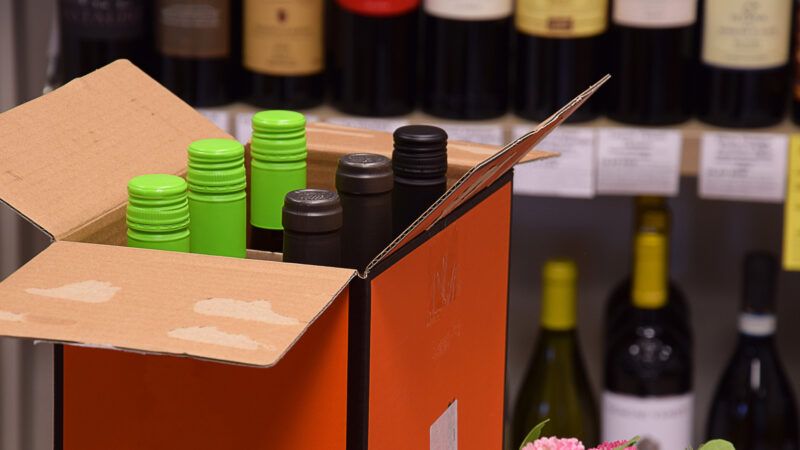New Research Shows Alcohol Delivery Is Not to Blame for Increased Drinking
There is no demonstrable link between alcohol delivery laws and our heightened pandemic drinking.

When it comes to Americans drinking during COVID-19, two things are clear. First, to-go and delivery alcohol laws spread across the country in unprecedented ways. Second, drinking went up. Given these two trends, opponents of alcohol delivery have suggested that allowing more alcohol delivery caused the uptick in drinking. But there is no data to actually back this up.
The liberalization of alcohol delivery laws was previously blamed for increases in drunk-driving deaths and underage drinking. But as in those instances, claims about alcohol delivery and increased overall drinking have been largely conjured out of thin air. Despite the pandemic starting over three years ago, there have been no comprehensive attempts to empirically find a link between drinking and delivery.
Using recent data from the National Institute on Alcohol Abuse and Alcoholism (NIAAA) Surveillance Report and comparing it to state alcohol delivery rules, the R Street Institute, where I am a senior fellow, recently filled this research gap by finding that alcohol delivery was not correlated with higher drinking rates.
News stories during the pandemic suggested that liberalizing alcohol delivery laws was causing Americans to drink more. As one Washington Post headline from December 2021 put it: "States rushed to loosen alcohol laws in the pandemic. Heavy drinking went up, some studies say."
The problem is that these "studies" said no such thing. It was clear that more states were allowing alcohol delivery. And there was also evidence showing that Americans were drinking more during COVID-19. But there were no studies showing a connection between these two things. In fact, numerous researchers suggested that "social stressors" like loneliness and greater demands during the pandemic were the likeliest causes of increased consumption.
Finally, in April 2022, an attempt to find a link between delivery and drinking was published in the journal Substance Abuse. The study authors surveyed just under a thousand participants in an online sample, asking them various questions about their drinking habits. One of the questions asked if they had alcohol delivered to their homes, and although only around 20 percent of respondents said yes, that subgroup reported higher drinking levels than those who had not had alcohol delivered.
While this survey provided some limited information, it did not demonstrate that alcohol delivery was the reason for these higher drinking rates. That's because the survey did not clarify whether the respondents who had alcohol delivered during the pandemic also drank more pre-pandemic than the non-delivery crowd. In other words, these respondents might have merely shifted their drinking from the corner bar to their home, rather than increasing their drinking. All of this points to an obvious possibility: that those who already drank more regularly were also the folks most likely to be interested in having alcohol delivered to their doors.
The authors of the study noted these potential substitution effects that could be at play and specifically clarified that "it is important to consider that the closure of licensed premises may have resulted in a shift in where participants consumed alcohol, rather than necessarily an increase in consumption…. We cannot tell whether the association between people who get alcohol delivered and the level of consumption has changed since the onset of alcohol home delivery."
To truly investigate potential connections between delivery and drinking, the best bet is to compare state-level drinking laws—i.e., states that allowed alcohol delivery before and during the pandemic vs. those that did not—and see how they varied when it comes to alcohol consumption. Doing so shows that the states with the most liberalized alcohol delivery laws did not have larger increases in drinking rates than states with the most restrictive laws—in reality, it was often the opposite.
For instance, in states that did not allow alcohol delivery from bars or restaurants, there was an increase in alcohol consumption in 2020 of 22.9 "drinks" per capita for those 21 and older. (Per the NIAAA, a "standard drink" of alcohol in the United States contains 0.6 fluid ounces of ethanol.) In contrast, in states that did allow alcohol delivery from bars and restaurants, there was an uptick of only 16.29 drinks per capita in 2020.
The results were similar for alcohol delivery from off-premise outlets such as liquor and grocery stores: States that restricted alcohol delivery actually had higher increases in pandemic-era drinking. Also of interest, the drinking rates for the 14 and above age demographic likewise mirrored these results—providing at least some evidence that alcohol delivery did not spike underage drinking rates either.
It is important to note that this data does not suggest that more liberalized alcohol delivery laws somehow led to less drinking. But it does show the lack of any demonstrable link between delivery laws and drinking rates. As with any area of policy, lawmakers should use data rather than scary anecdotes and hyperbolic news headlines to guide their decision making.
This matters because, while there have not yet been any widespread attempts to roll back alcohol delivery laws enacted during COVID, opponents of such rules are becoming increasingly vocal. Certain law enforcement unions, health advocacy organizations, and even some state lawmakers are citing concerns over alcohol delivery.
These sentiments have seeped into the legislative arena. A bill was recently introduced in Arkansas to repeal the state's 2021 delivery law, while California is considering legislation that, while it wouldn't repeal the state's alcohol delivery law, would make delivery licenses and driver training substantially more expensive and onerous.
As such efforts continue to spread, it will be vital for policy makers to recognize an important reality: More widespread delivery laws were not the true cause of our heightened pandemic drinking.


Show Comments (13)